Special Issue Article Open Access
Comparison of Trichloroethylene Toxicity, Removal, and Degradation by Varieties of Populus and Salix for Improved Phytoremediation Applications
| Rachel S. Miller, Zareen Khan and Sharon L. Doty* | |
| School of Forest Resources, College of the Environment, University of Washington, Seattle, WA 98195-2100, USA | |
| Corresponding Author : | Sharon Lafferty Doty School of Forest Resources College of the Environment, University of Washington Seattle, WA 98195-2100,USA Tel: (206)616-6255 E-mail: sldoty@uw.edu |
| Received: October 24, 2011; Accepted: November 23, 2011; Published: November 30, 2011 | |
| Citation: Miller RS, Khan Z, Doty SL (2011) Comparison of Trichloroethylene Toxicity, Removal, and Degradation by Varieties of Populus and Salix for Improved Phytoremediation Applications. J Bioremed Biodegrad S7:001. doi:10.4172/2155-6199.S7-001 | |
| Copyright: © 2011 Miller RS, et al. This is an open-access article distributed under the terms of the Creative Commons Attribution License, which permits unrestricted use, distribution, and reproduction in any medium, provided the original author and source are credited. | |
Related article at Pubmed Pubmed  Scholar Google Scholar Google |
|
Visit for more related articles at Journal of Bioremediation & Biodegradation
Abstract
Trichloroethylene (TCE), a chlorinated organic solvent, is one of the three most common and widespread groundwater contaminants worldwide. Exposure to this contaminant has been linked to liver and kidney toxicity and cancer in humans and animals [1]. The Salicaceae family, which includes poplar and willow trees, has been very successful in phytoremediation efforts involving chlorinated solvents including TCE. Previous phytoremediation studies investigated removal of this contaminant using one or two genotypes, but a screening of a large number of genotypes in this family of plants had not yet been conducted. In this study, nine Populus and twelve Salix varieties were chosen for their previous success in phytoremediation efforts or local native significance, and experiments were conducted to compare toxicity, uptake, and degradation of TCE. Results from the toxicity screening demonstrated that hybrid poplar clones Crandon (Populus alba x grandidentata), Nisqually-1 (P. trichocarpa), D.Pa (P. alba) and willow clone S365 (Salix discolor) had the highest mass gain and best health at the highest TCE concentration. Percent removal of TCE in one week ranged from 19.2 to 44.9 with Crandon, P. deltoides hybrid 91x0403, poplar clone H11-11 (P. trichocarpa x deltoides), Salix sitchensis clone B, and Nisqually-1 all removing more than 40 percent of the TCE from hydroponic solution. In terms of TCE degradation, S. sitchensis clone B, poplar hybrid 91x0403, and hybrid poplar H11-11 had the most TCE metabolite, trichloroethanol, per gram of fresh plant weight, with the best performer, S. sitchensis clone B, having eight times the amount than the lowest genotype tested. These results indicated that there are significant differences in the ability of poplar and willow genotypes to remove and degrade TCE, and that many different genotypes could be successfully utilized for phytoremediation of TCE. This data set could be applied toward choosing the appropriate genotypes for the phytoremediation of TCE in a given location and climate.
| Keywords |
| Trichloroethylene; TCE; Phytoremediation; Poplar; Willow |
| Introduction |
| Development of military, industry, and technology has introduced an abundance of harmful contaminants into the environment. One of the most predominant groundwater contaminants is trichloroethylene (TCE), a halogenated hydrocarbon [2]. TCE was one of the most frequently detected volatile organic compounds (VOCs) in a U.S. Environmental Protection Agency sampling survey of 945 groundwater-based drinking water supplies [3]. In addition, it is one of the most frequently detected organic pollutants at U.S. National Priorities List (NPL) or Superfund sites, with TCE identified at 852 of the 1430 NPL sites as of September 1997. Now more than 50% of SuperFund sites in the United States are contaminated with TCE [4]. Superfund sites with TCE groundwater contamination include military facilities, drycleaners, and electronic manufacturing plants. In most cases the groundwater pollution resulted from unregulated disposal and storage of liquid solvent wastes between 1940 and 1970. TCE exposure can result in liver and kidney toxicity, and depression of the central nervous system. TCE was also labeled as being a ‘probable human carcinogen’ based on induction of kidney tumors in rats, considered relevent as a predictor of human cancer [1]. |
| Current remediation efforts are widespread and include mechanical, chemical and biological derived engineering methods. Mechanical and chemical methods of remediation include soil venting, air sparging, pump and treat techniques, and granular activated carbon (GAC) adsorption [5]. The process of removal of the contaminants uses large amounts of energy, can cause significant ecosystem damage, and often do not fully remove the contaminant from the environment in question. The associated costs of mechanical and chemical environmental remediation are large, with $6–8 billion per year is spent in the United States and $25–50 billion per year worldwide [6]. Recently, focus has shifted towards bioremediation of these contaminants via in situ application of bacteria that have the capacity to degrade the chlorinated compounds to non toxic forms [7]. Dehalococcoides is of particular interest and although members of this genus are known to completely reduce TCE to ethane, effective application of this strategy still has to overcome certain limitations [8]. More recently, phytoremediation, a biological method of remediation which uses plants as a natural solar powered pump and treat system, is being used to remove contaminants from the air, soil and groundwater. This method is inexpensive and nonintrusive as a method of contamination removal. Plants, especially large trees, have a root structure that has the potential to stabilize contaminants from migration and can often reach the water table and uptake contaminated groundwater without the need for external machinery. Some plants have the ability to naturally withstand a variety of toxic substances and have been used to successfully remediate a wide range of pollutants [9]. Depending on the contaminant and its chemical properties, certain plants can degrade harmful compounds into harmless elemental components. Phytoremediation as a method of contamination removal is gaining significant attention as a more benign method than some of the current engineering practices. |
| Current phytoremediation practices must utilize plants that grow well in the region of the contamination. Subsequently, plant viability is essential in the successful application of phytoremediation. Poplar (Populus) and willow (Salix) comprise the family Salicaceae, and have shown promise in phytoremediation applications due to their extensive rooting system, rapid growth, high toxicity tolerance, and high water uptake rates [10]. These species are perennial, long-lived (80-100 years), fast growing, hardy, and easily propagated, providing high biomass and an extensive root system. The Salicaceae family is widely distributed over the northern hemisphere and indigenous to almost every continent. Salicales includes the familiar genera Populus (poplars, cottonwoods, and aspens) and Salix (willows, sallows, and osiers). Together Populus and Salix comprise 400 to 500 species. Their ability to re-colonize and establish quickly into substantial trees has made them an important resource for forest restoration and biofuel applications [11,12] The wide genetic breadth, quick growth, wide distribution and multiple use end product (ie., wood and biofuel) make members of this family great candidates for phytoremediation applications. The use of cuttings is the routine method used for the propagation of the Salicaceae family. This method offers the advantage of using clones in experiments, thus avoiding genetic variability in individual experiments. In phytoremediation applications, the use of one clone is a common practice. This method of using one clone, however, limits the benefits that a diverse range of genetics could provide both in contaminant removal and disease resistance. Susceptibility of certain genotypes of poplars to a variety of insects and diseases have been shown to be highly variable and under strong genetic control [13,14]. Disease and pest infestations can potentially disrupt, and ultimately stop the process of phytoremediation. A benefit of using many different genotypes of plants is that it provides a safeguard to a monoculture that could get entirely affected by disease or insects [15]. Studies have shown that hybrid poplar can take up and degrade TCE [16-18], and studies using 14C labeled-TCE assisted in identifying several metabolites (Table 1) (Figure 1) which allowed for complete mineralization to CO2 to be observed [19,20]. The biochemical studies of TCE degradation have been limited to only a few hybrid poplar clones. With a data set of many poplar and willow genotypes that are successful in the removal of TCE, phytoremediation of this contaminant can be more effective. To this end, the goal of this study was to screen poplar and willow that have been successful in phytoremediation applications, and some that have not yet been examined for this use in order to identify the best performing genotypes based on resistance to the toxic effects, TCE uptake, and TCE degradation. The genotypes with these qualities would be the best candidates for TCE phytoremediation applications. |
| Materials and Methods |
| Plant material |
| A variety of plant genotypes were screened for this study. Nisqually-1 (P. trichocarpa) was one of the plant lines chosen as it is native to the Pacific Northwest and because it has become a model poplar clone for genomics studies [21]. D.Pa, (named for Duwamish Populus alba) was chosen for its resiliency to toxins at a restoration site at the Duwamish River Superfund site. Poplar clone H11-11 (P. trichocarpa x deltoides) was selected as it was the determined by early biochemical studies to actively degrade TCE [16,20]. The fourth locally-obtained clone was Native Willow B (Salix sitchenses) from the Snoqualmie River area in Western Washington state. Other genotypes were selected based on use in environmental applications across the United States. S365 (Salix discolor), a fast-growing and easily propagated willow clone, and Crandon (P. alba x grandidentata) have been used successfully in phytoremediation efforts in the Midwest USA (Environmental Forestry Consultants, Illinois). A total of 21 plant lines of the Salicaceae family were chosen for this study, and these are listed with genotype and origin (Table 2). |
| TCE phytotoxicity |
| Cuttings were taken from each clone and surface sterilized in a sterile hood (Baker Company) with 0.525% sodium hypochlorite solution (10% commercial bleach) for 10 minutes, and 1% Iodophor solution for 5 minutes, rinsed several times with sterile water, and placed in Magenta GA-7 (Phytotechnology Laboratories, Kansas) plant culture boxes containing Murashige and Skoog [22] agar medium balanced to pH 5.7 for rooting and propagation. |
| To evaluate the toxicity of TCE to the plant lines, each plant line, in triplicate, was first individually weighed (fresh weight), and then exposed to a range of TCE concentrations for one week. Plant cuttings were placed in sterile 40-mL clear Volatile Organics Analysis (VOA) vials containing 10 mL of ½ strength Hoagland’s nutrient broth [23], and resealed with Mininert caps to prevent escape of volatile TCE. In a fume hood, using a Luer Lock 2.5mL syringe (Hamilton), TCEsaturated solution (~1800 μg/mL ), prepared by adding pure TCE (Sigma Aldrich; 99.5% purity) to a sealed amber vial mixed overnight on a stir plate, was added to each VOA vial. Final concentrations of TCE in the Hoagland’s’ solution of 0, 50, 100, 150, and 200μg/mL were achieved by adding an appropriate amount of TCE-saturated solution. After incubation at approximately 24Ã?Â?C for 7 days with a 14-h photoperiod, the plants were weighed again and health was assessed. All plants dosed at 200μg/mL TCE were frozen with liquid nitrogen and stored at -80Ã?Â?C immediately after they were weighed. These plant samples were later used for metabolite identification. Fresh weight at day zero and day seven (in grams) and health was noted for each plant tested. A qualitative measurement of health was given on a scale of 0 to 5, with 5 given to plants that exhibited new growth during the week and no sign of chlorosis, and with 0 given to dead plants. |
| TCE uptake |
| TCE uptake from hydroponics was determined for each plant line. Plant cuttings (in triplicate) were weighed, surface sterilized, and placed in sterile 40-ml VOA vials containing 14 mL of ½ strength Hoaglands’ nutrient broth and resealed with septum valves (Mininert) to prevent escape of volatile TCE during sampling. The plant lines were exposed to 10μg/mL TCE. This low TCE concentration was chosen as it allows for more accurate quantification of TCE by gas chromatography with an electron capture detector (GC-ECD). Three unplanted control vials were prepared to test for leakage of the system due to the high volatility of TCE. Standard TCE extraction protocols were followed [24]. Two to three hours were allowed for the TCE to equilibriate with the plant nutrient solution before sampling. Four milliliters of hydroponic solution were removed through the mini-nert valve and placed in a 15mL amber vial with a silicone septa cap screw top lid (Supelco) containing 2mL of 10% NaCl and 5mL of hexane (Sigma Aldrich; 99.5% purity) and mixed by inversion for one minute. One milliliter of the hexane layer was placed into a 2mL amber crimp vial and immediately capped with a silicone septa crimp lid (Supelco) to be analyzed by gas chromatography. Standard solutions of 0.0015μg/mL, 0.015μg/mL, 0.15μg/mL, and 1.5μg/mL of pure TCE were prepared in hexane to make a standard curve. A second, final sampling of the hydroponic solution was taken after incubation at 24Ã?Â?C for 7 days with a 14-h photoperiod. At the time of the second sampling, the plants were weighed again and this number was averaged with the day zero weight and used to normalize TCE uptake from solution per gram of plant tissue. A Perkin Elmer (Norwalk, CT, USA) gas chromatograph (GC) Model Clarus 500 series equipped with 63Ni electron capture detection (ECD) system and a PTE-5 (5% phenyl methyl siloxane) fused-silica capillary column (30 m × 0.32 mm ID; thickness, 0.32 μm) was used (Supelco). The GC-ECD conditions were as reported earlier [20]. |
| Quantification of TCOH as an indicator of TCE metabolism |
| To quantify trichloroethanol (TCOH), a major TCE metabolite, from the tissues of the genotypes, plants dosed to a level of 200 μg/ mL TCE from the phytotoxicity screening test were removed from the -80Ã?Â?C and maintained on dry ice until processed. Individual pre-chilled mortar and pestles were used for grinding and extraction. Plants were subjected to extraction of the chlorinated compounds as described by Doty et al. [25], and analyzed by GC-ECD. Solutions of 0.0015μg/mL, 0.015μg/mL, 0.15μg/mL, and 1.5μg/mL of pure TCOH (Lancaster, 98% purity) were made by dilution in hexane in order to make a standard curve for quantification. Peak areas were converted to TCOH concentrations and then normalized per gram of plant tissue. Although the majority of TCOH in plants is conjugated to glucoside [20], we analyzed only for the free TCOH for this screening study. |
| Two types of controls were used, undosed and spiked control plants, in order to determine retention time of TCOH in plant tissue for GC analysis. Both undosed and spiked control plants were grown for one week in 14 mL of ½ strength Hoaglands’ nutrient media broth in sterile VOA vials, frozen with liquid nitrogen and stored at -80Ã?Â?C until analyzed. Tissues of the controls were ground as described, and 100 μL of the 15μg/mL TCOH standard solution was added to the spiked control samples prior to centrifugation in glass tubes (Corex). Extraction was carried out as with experimental samples and peaks from spiked samples were used to identify retention time of TCOH. |
| Statistical analysis |
| One-way ANOVA, Tukey Honestly Significant Difference post-hoc analysis [26], t-tests and Pearsons product moment correlation coefficient test were conducted using SPSS statistical software version 16.0. |
| Results |
| TCE phytotoxicity |
| Plant health was assessed after one week exposure at the highest concentration of 200μg/mL TCE (Figure 2). Crandon, Nisqually-1, and S365 showed the highest tolerance to the phytotoxicity of TCE, gaining the most weight, 0.17, 0.16, and 0.15 grams, respectively, over the duration of the experiment. Sx64, 99207-018, and Sx61 showed a large variation of weight loss, with one of the Sx61plants gaining 0.6 grams and another losing 0.7grams, making the determination of phytotoxic effects difficult for this clone. H11-11 and SV1 had high health code values without any significant weight change. Crandon and S365 had the highest health code values on average. Pearson product-moment correlation coefficient test was conducted to determine the relationship between health code and weight change. There was a strong positive correlation between health and weight in this experiment, which was statistically significant (r=0.351, n=240, P<0.0005). Overall, most plant lines did well at even these high levels of TCE. |
| TCE uptake |
| Percent removal was calculated based on μg of TCE removed in the one week (Figure 3). The poplars removed between 36.4-44.9 % with a mean standard error ± 5.7 %, while Crandon, H11-11, and 91x0403 removed the most μg of TCE, without being normalized per gram of fresh plant weight. Crandon had the highest percent removal of TCE from hydroponic solution in the uptake experiment, at 44.9%, with H11-11 and 91x0403 both removing 44.8% of the TCE in one week. Willows removed between 19.2-40.9% with a mean standard error ± 10.4%, while Native Willow B removed the most μg of TCE of all the willow lines tested. Whether normalized by plant weight or not, Native Willow B (M=40.9, SEM=6.4), Nisqually-1 (M=40.0, SEM=4.2), and H11-11 (M=44.8, SEM=5.7), were in the top five performers. Means were found to be significantly different (t(21)=17.439, P=0.000), and all plant lines removed more TCE (M=32.26, SEM=1.6) than the unplanted controls (M=11.2, SEM=3.2). |
| Quantification of TCE metabolism |
| A subset of the plant lines were chosen for metabolite studies based on the results of the previous toxicity and uptake experiments (Figure 4). The tissues from the plants dosed with 200μg/mL TCE were extracted for TCE metabolites and analyzed by GC-ECD. Trichloroethanol is the dominant, most directly measurable TCE metabolite in plants [20]. The clones with the highest average amount of free (unconjugated) TCOH normalized to plant mass were Native Willow B (M=2.01, SEM=0.12), 91x0403(M=1.54, SEM=0.26), H11-11(M=1.50, SEM=0.06), and Sx67 (M=1.30, SEM=0.16). All four of these plant lines had more than 1.30 μg TCOH per gram of fresh weight. In addition to these top four varieties, Crandon removed >1.24μg TCOH per gram of fresh weight, which post hoc analysis revealed could not be separated from the rest of these top-performing genotypes. Native Willow B was the best performing plant line with more than 8 times the extractable TCOH than the plant line with the least amount. Post-hoc analysis using the Tukey Honestly Significant Difference revealed Native Willow B as the only significantly different genotype at the p=0.05 significance level (Figure 5). |
| Discussion |
| The overall objective of this study was to identify the best performing genotypes in the family Salicaceae for the uptake and degradation of one of the most common pollutants, trichloroethylene. Assessments of tolerance to high levels of TCE and quantification of TCE uptake and degradation indicated differences between genotypes in TCE phytoremediation potential. The best performing plant line for phytoremediation of trichloroethylene would be one that showed no toxic effects when exposed to high concentrations of TCE, removed a large percentage of the TCE from hydroponics, and metabolized that which it took up. Few clones performed well in all three categories. Since some of the plant lines did not perform well in the health tests whether or not TCE was present (data not shown), this assay is probably not reflective of how the lines would perform in a natural outdoor setting. |
| The Crandon clone ranked high in both the toxicity and uptake experiments and was in the top five for the TCE metabolism experiment. And, although it did not grow during the toxicity experiment, Native Willow line B was the best clone tested in the TCE metabolism experiment and was the best performing willow in the TCE uptake experiment. The 91x0403 clone was the best performing poplar in the metabolism experiment, it was in the top three in the uptake experiment, and it had a high health code value when exposed to the highest concentration tested in the toxicity experiment. |
| There were few notable patterns visible among the genetically similar clones tested. The ability of P. deltoides clones to metabolize TCE was highly variable, with D105 and 7300501 producing little free TCOH while 91x0403 was one of the best TCE degraders, even though all three of these clones are of the same species. Nisqually-1 and H11- 11 share P. trichocarpa parentage and among all three parameters, H11-11 out-performed Nisqually-1 in health, uptake and free TCOH. H11-11 and 91x0403 share P. deltoides parentage and showed the same trends with very close values in health and TCE uptake with an identical amount of free TCOH extracted. The willow clones Sx64 and Sx67 are both S. miyabeana and performed similarly with no statistical difference in uptake and TCOH extraction, and the difference in weight and health being due to one Sx64 plant dying during the experiment. To assess the mechanisms and genetic lineage responsible for uptake and degradation of TCE, the actual maternal and paternal clones must be examined. Further research in this area could provide insight into choosing or developing the best clone for a given TCE remediation site and a greater understanding of the mechanisms involved in the metabolism of TCE in planta. |
| Multiple studies have suggested a hypothetical three step pathway for the metabolism of TCE in plant tissues: (1) oxidative reactions from TCE to TCOH which are presumed to be catalyzed by cytochrome P450 monooxygenases; (2) conjugation with a plant molecule catalyzed by glutathione S-transferases (GST) or glucosyltransferases; (3) sequestration of the conjugate into the cell wall or in the vacuole by transporters (Reviewed in [27]). There is large variability in the expression of genes predicted to be involved in xenobiotic metabolism between genetically different plant lines [28]. Therefore, differences in gene regulation could be one of the reasons for the differences in TCE degradation ability within the genotypes tested. The specific P450 involved in TCE degradation in plants has not yet been identified. Since the activation step is the rate-limiting step in TCE degradation [24,25], a better understanding of the differences in the regulation of the gene encoding the responsible P450 could aid in screening for the best genotypes for TCE degradation. |
| The results of the experiments conducted in our study indicated that many different genotypes could be utilized for phytoremediation of TCE but that there is significant variation in the abilities of plants to take up and degrade TCE. It was surprising that the best TCE degrading genotype out of all those tested was a wild willow isolated from a riparian system presumably free of TCE. Therefore, the best genotype for use in phytoremediation of TCE may be a local variety previously not utilized for this purpose. With the data set established by these experimental results, the proper plants could be chosen for a given TCE phytoremediation site based on native origin of the plant and environment in which it will need to work. This study also provides the framework for rapid screening of other genotypes. Recently, research into improving phytoremediation has turned to using endophytes (microbes living inside plants) to reduce phytotoxic effects and increase pollutant degradation [29-31]. By optimizing both the plant genotypes and the microbial partners, profound improvements in phytoremediation applications may be in the future. |
| Acknowledgements |
| We thank the following people for providing the plants used in this study: Milton Gordon for clone H11-11; Jud Isebrands (Environmental Forestry Consultants, Illinois) and Lawrence Smart (SUNY) for the clones Crandon, D105, 7300501, 9425-35, S365, Sx64, Sx61, Sx67, SV1, 94006, 99239-015, 01x-268-015, 99207- 018, and 9871-31; Richard Hall (Iowa State University) for clone 91x0403 and Crandon; and Cetin Yuceer (Missisippi State University) for clone ST-148. This work was funded through the NSF Environmental Engineering grant CBET- 0829027. |
References
|
Tables and Figures at a glance
| Table 1 | Table 2 |
Figures at a glance
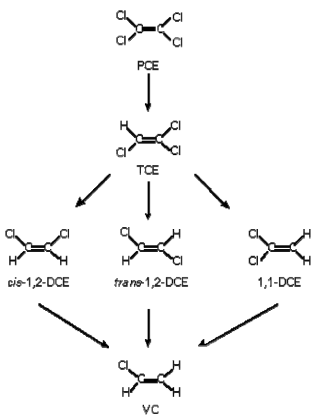 |
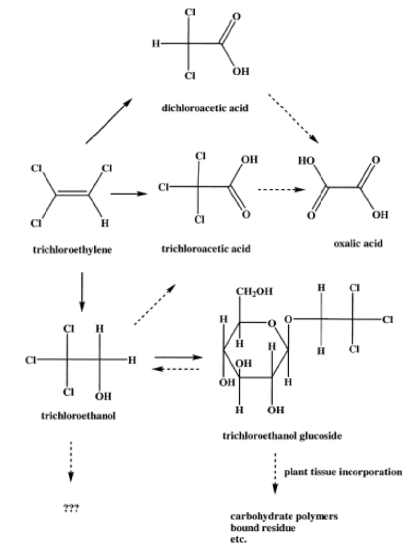 |
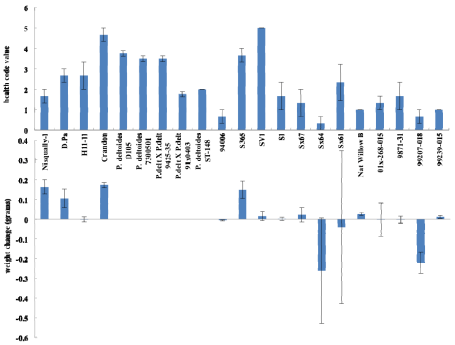 |
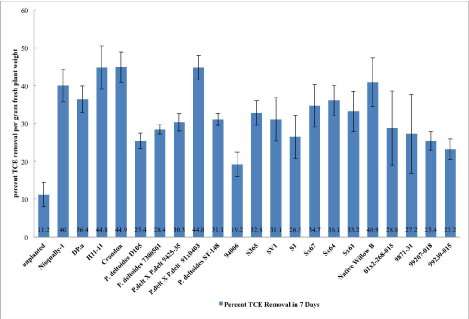 |
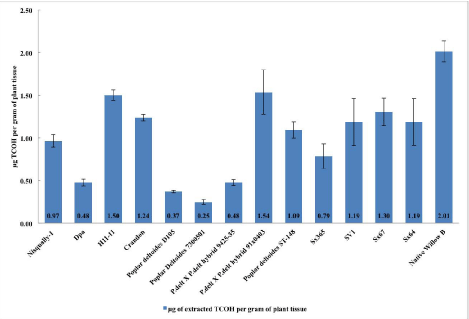 |
| Figure 1 | Figure 2 | Figure 3 | Figure 4 | Figure 5 |
Relevant Topics
- Anaerobic Biodegradation
- Biodegradable Balloons
- Biodegradable Confetti
- Biodegradable Diapers
- Biodegradable Plastics
- Biodegradable Sunscreen
- Biodegradation
- Bioremediation Bacteria
- Bioremediation Oil Spills
- Bioremediation Plants
- Bioremediation Products
- Ex Situ Bioremediation
- Heavy Metal Bioremediation
- In Situ Bioremediation
- Mycoremediation
- Non Biodegradable
- Phytoremediation
- Sewage Water Treatment
- Soil Bioremediation
- Types of Upwelling
- Waste Degredation
- Xenobiotics
Recommended Journals
Article Tools
Article Usage
- Total views: 15465
- [From(publication date):
specialissue-2013 - Apr 03, 2025] - Breakdown by view type
- HTML page views : 10849
- PDF downloads : 4616
